
C7
.pdf
7
T H E R O M A N E M P I R E
With the rise and triumph of Rome, a single government ruled, for the first time in history, from the Strait of Gibraltar to the Nile, from the Tigris and Euphrates to the Rhine, Danube, Thames and beyond (MAP 7-1). Within the Roman Empire’s borders lived millions of people of numerous races, religions, tongues, and cultures: Britons and Gauls, Greeks and Egyptians, Africans and Syrians, Jews and Christians, to name but a few. Of all the ancient civilizations, the Roman most closely approximated
today’s world in its multicultural character.
Roman monuments of art and architecture, spread throughout the vast territory the Romans governed, are the most conspicuous and numerous of all the remains of ancient civilization. In Europe, the Middle East, and Africa today, Roman temples and basilicas have an afterlife as churches. The powerful concrete vaults of ancient Roman buildings form the cores of modern houses, stores, restaurants, factories, and museums. Bullfights, sports events, operas, and rock concerts are staged in Roman amphitheaters. Ships dock in what were once Roman ports, and Western Europe’s highway system still closely follows the routes of Roman roads.
Ancient Rome also lives on in the Western world in concepts of law and government, in languages, in the calendar—even in the coins used daily. Roman art speaks in a language almost every Western viewer can readily understand. Its diversity and eclecticism foreshadowed the modern world. The Roman use of art, especially portraits and narrative reliefs, to manipulate public opinion is similar to the carefully crafted imagery of contemporary political campaigns. And the Roman mastery of concrete construction began an architectural revolution still felt today.
The center of the far-flung Roman Empire was the city on the Tiber River that, according to legend, Romulus and his twin brother Remus founded on April 21, 753 BCE. Their Rome consisted only of small huts clustered together on the Palatine Hill (FIG. 7-2, no. 3) overlooking what was then uninhabited marshland. In the Archaic period, Rome was essentially an Etruscan city, both politically and culturally. Its greatest shrine, the Temple of Jupiter Optimus Maximus (Best and Greatest) on the Capitoline Hill, was built by an Etruscan king, designed by an Etruscan architect, made of wood and mud brick in the Etruscan manner, and decorated with terracotta statuary created by an Etruscan sculptor (see “Etruscan Artists in Rome,” Chapter 6, page 146).
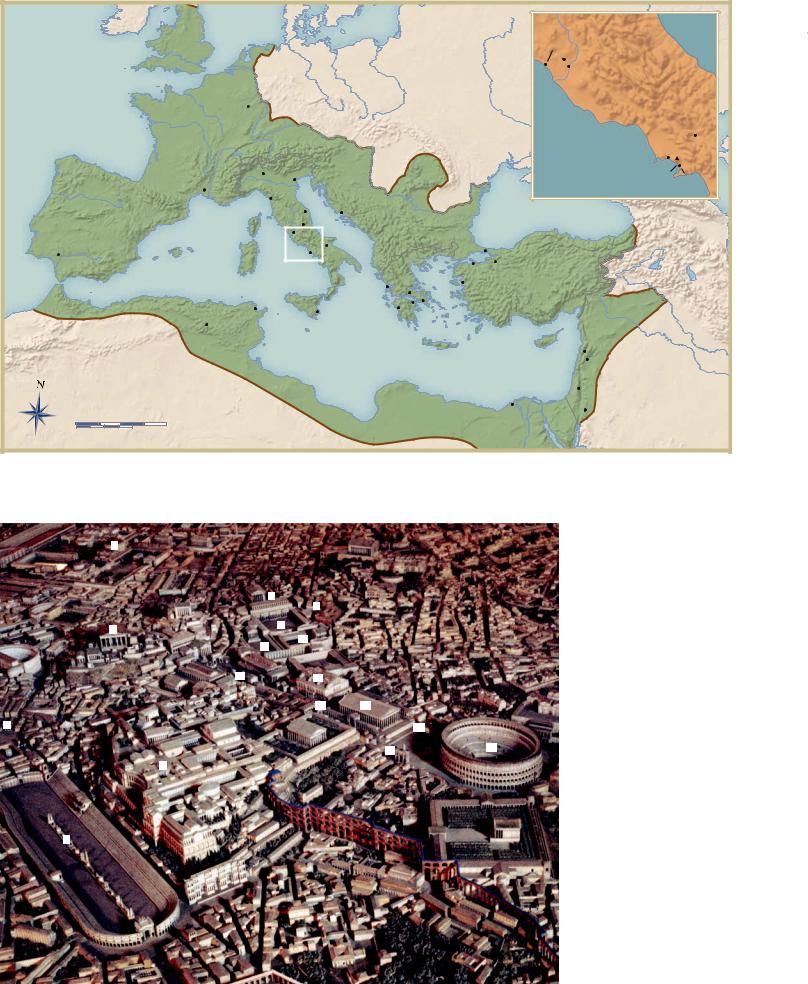
ATLANTIC
OCEAN
SPAIN
Italica
North
Sea
ENGLAND |
|
|
|
|
|
|
|
|
T |
|
|
|
|
|
|
|
|
h |
|
|
|
|
|
|
|
|
a |
|
|
|
|
|
|
|
|
m |
|
|
|
|
|
|
|
|
es |
|
R |
|
|
|
|
|
|
R. |
|
|
|
|
|
|
|
|
|
|
h |
|
|
|
|
|
|
|
|
e GERMANY |
|
|
||||
|
|
i |
|
|
|
|
|
|
|
|
n |
|
|
|
|
|
|
|
|
R |
|
|
|
|
|
|
|
|
. |
|
|
|
|
|
|
|
|
Trier |
D |
|
|
|
|
|
|
|
|
|
|
|
|
||
|
|
|
|
a |
|
|
|
|
|
|
|
|
n |
|
|
|
|
|
|
|
|
|
u |
|
|
|
FRANCE |
|
|
|
|
be |
R. |
||
|
|
|
|
|
|
|||
|
. |
|
|
|
|
|
|
|
|
R |
|
|
|
|
|
|
|
|
e |
Milan |
|
|
|
|
|
|
|
n |
Venice |
|
|
|
|||
|
ô |
|
|
|
|
|||
Nîmes |
h |
|
|
|
|
|
|
|
R |
ITALY |
|
|
|
CROATIA |
|||
|
|
Carrara |
A |
|
|
|
|
|
|
|
Osimo |
d |
|
|
Split |
||
|
|
|
i |
|
||||
|
|
|
|
r |
|
|
|
|
|
|
|
|
|
a |
|
||
|
|
Amiternum |
|
|
t |
|
||
|
|
|
|
|
c |
|
||
|
|
|
|
|
|
|
i |
|
|
|
|
|
|
|
|
S |
|
|
|
|
|
|
|
|
|
e |
|
|
|
Rome |
|
|
|
a |
|
|
|
|
|
|
|
|
||
|
|
|
Naples |
|
|
|
Melfi |
|
ROMANIA
D |
u |
. |
|
R |
|||
|
an be |
||
|
|
Constantinople
(Istanbul)
T |
|
i |
Adriatic |
r |
|
b |
|
e |
Sea |
. |
|
R |
|
Cerveteri
Veii
Primaporta
Rome
 Tivoli
Tivoli
 Ostia
Ostia  Palestrina
Palestrina
Benevento
Mt. Vesuvius
Tyrrhenian Naples  Boscoreale
Boscoreale
Sea Herculaneum
 Nuceria
Nuceria
Boscotrecase Pompeii
Black Sea
|
|
Tyrrhenian |
|
GREECE |
Cyzicus |
Nicaea |
||
|
|
Sea |
|
|
Pergamon TURKEY |
|||
|
|
|
|
|
DelphiAegean |
|||
|
|
|
|
Actium |
|
n |
|
|
|
|
S i c i l y |
|
Corinth |
Athens |
|
|
|
|
|
|
Olympia |
|
|
|||
|
|
Carthage |
|
|
|
|||
|
Timgad |
Syracuse |
|
Sea |
|
|
||
|
TUNISIA |
|
|
|
|
|
||
ALGERIA |
|
|
|
|
|
SYRIA |
||
|
|
|
|
|
|
|||
|
|
|
|
|
|
|
||
Mediterranean Sea |
Baalbek |
|
Damascus |
||
|
P A R T H I A
T |
|
i |
|
g |
|
r |
|
i |
|
s |
|
R |
|
|
. |
E |
|
u |
|
p |
|
h |
|
r |
|
at |
|
es |
|
|
R. |
 Lepcis Magna
Lepcis Magna
0 |
|
200 |
400 miles |
0 |
200 |
400 kilometers |
|
LIBYA
Alexandria
EGYPT
FAIYUM
Jerusalem
Petra
. R
e l i N
A R A B I A
MAP 7-1 The Roman Empire at the death of Trajan in 117 CE. |
|
|
|
|
|
|
|
|
7-2 Model of the city of |
5 |
|
|
|
Rome during the early fourth |
|
|
|
|
century CE. Museo della |
|
|
|
|
Civiltà Romana, Rome. |
|
6 |
|
|
(1) Temple of Portunus, |
|
|
|
(2) Circus Maximus, |
|
|
8 |
|
|
|
|
7 |
|
|
(3) Palatine Hill, (4) Temple |
4 |
|
|
of Jupiter Capitolinus, |
|
10 |
|
|
||
|
|
|
(5) Pantheon, (6) Column of |
|
|
9 |
|
|
|
|
|
|
|
Trajan, (7) Forum of Trajan, |
11 |
12 |
|
|
(8) Markets of Trajan, |
|
|
|
|
(9) Forum of Julius Caesar, |
|
13 |
14 |
|
(10) Forum of Augustus, |
1 |
|
|
16 |
(11) Forum Romanum, |
|
|
(12) Basilica Nova, (13) Arch |
||
|
|
|
|
|
|
|
15 |
17 |
of Titus, (14) Temple of |
3 |
|
|
|
Venus and Roma, (15) Arch |
|
|
|
|
of Constantine, (16) Colossus |
|
|
|
|
of Nero, (17) Colosseum. |
|
|
|
|
By the time of Constantine, |
|
|
|
|
the city of Rome was densely |
2 |
|
|
|
packed with temples, forums, |
|
|
|
|
triumphal arches, theaters, |
|
|
|
|
baths, racetracks, aqueducts, |
|
|
|
|
markets, private homes, and |
|
|
|
|
apartment houses. |
158 Chapter 7 T H E RO M A N E M P I R E

A R T A N D S O C I E T Y
An Outline of Roman History
MONARCHY (753–509 BCE)
Latin and Etruscan kings ruled Rome from the city’s founding by Romulus and Remus until the revolt against Tarquinius Superbus (exact dates of rule unreliable).
REPUBLIC (509–27 BCE)
The Roman Republic lasted from the expulsion of Tarquinius Superbus until the bestowing of the title of Augustus on Octavian, the grandnephew of Julius Caesar and victor over Mark Antony in the civil war that ended the Republic. Some major figures were
Marcellus, b. 268(?), d. 208 BCE, consul
Marius, b. 157, d. 86 BCE, consul
Sulla, b. 138, d. 79 BCE, consul and dictator
Pompey, b. 106, d. 48 BCE, consul
Julius Caesar, b. 100, d. 44 BCE, consul and dictator
Mark Antony, b. 83, d. 30 BCE, consul
EARLY EMPIRE (27 BCE–96 CE)
The Early Empire began with the rule of Augustus and his JulioClaudian successors and continued until the end of the Flavian dynasty. Selected emperors and their dates of rule (with names of the most influential empresses in parentheses) were
Augustus (Livia), r. 27 BCE–14 CE
Tiberius, r. 14–37
Caligula, r. 37–41
Claudius (Agrippina the Younger), r. 41–54
Nero, r. 54–68
Vespasian, r. 69–79
REPUBLIC
In 509 BCE the Romans overthrew Tarquinius Superbus, the last of Rome’s Etruscan kings, and established a constitutional government (see “An Outline of Roman History,” above). The new Roman Republic vested power mainly in a senate (literally, “a council of elders,” senior citizens) and in two elected consuls. Under extraordinary circumstances, a dictator could be appointed for a specified time and a specific purpose, such as commanding the army during a crisis. All leaders came originally from among the wealthy landowners, or patricians, but later also from the plebeian class of small farmers, merchants, and freed slaves.
Before long, the descendants of Romulus conquered Rome’s neighbors one by one: the Etruscans and the Gauls to the north, the Samnites and the Greek colonists to the south. Even the Carthaginians of North Africa, who under Hannibal’s dynamic leadership had annihilated some of Rome’s legions and almost brought down the Republic, fell before the mighty Roman armies.
Architecture
The year 211 BCE was a turning point both for Rome and for Roman art. Breaking with precedent, Marcellus, conqueror of the fabulously wealthy Sicilian Greek city of Syracuse, brought back to Rome not only the usual spoils of war—captured arms and armor, gold and silver coins, and the like—but also the city’s artistic patrimony. Thus began, in the words of the historian Livy, “the craze for works of
Titus, r. 79–81
Domitian, r. 81–96
HIGH EMPIRE (96–192 CE)
The High Empire began with the rule of Nerva and the Spanish emperors, Trajan and Hadrian, and ended with the last emperor of the Antonine dynasty. The emperors (and empresses) of this period were
Nerva, r. 96–98
Trajan (Plotina), r. 98–117
Hadrian (Sabina), r. 117–138
Antoninus Pius (Faustina the Elder), r. 138–161
Marcus Aurelius (Faustina the Younger), r. 161–180
Lucius Verus, coemperor with Marcus Aurelius, r. 161–169
Commodus, r. 180–192
LATE EMPIRE (193–337 CE)
The Late Empire began with the Severan dynasty and included the so-called soldier emperors of the third century, the tetrarchs, and Constantine, the first Christian emperor. Selected emperors (and empresses) were
Septimius Severus (Julia Domna), r. 193–211
Caracalla (Plautilla), r. 211–217
Severus Alexander, r. 222–235
Trajan Decius, r. 249–251
Trebonianus Gallus, r. 251–253
Diocletian, r. 284–305
Constantine I, r. 306–337
Greek art.”1 Exposure to Greek sculpture and painting and to the splendid marble temples of the Greek gods increased as the Romans expanded their conquests beyond Italy. Greece became a Roman province in 146 BCE, and in 133 BCE the last Attalid king of Pergamon willed his kingdom to Rome (see Chapter 5). Nevertheless, although the Romans developed a virtually insatiable taste for Greek “antiques,” the Etruscan basis of Roman art and architecture was never forgotten. The buildings and statues of the Roman Republic are highly eclectic, drawing on both Greek and Etruscan traditions.
TEMPLE OF PORTUNUS, ROME Eclecticism is the primary characteristic of the Republican temple on the east bank of the Tiber popularly known as the Temple of Fortuna Virilis (FIGS. 7-2, no. 1, and 7-3). It is actually a temple dedicated to Portunus, the Roman god of harbors. Its plan follows the Etruscan pattern with a high podium and a flight of steps only at the front. Freestanding columns are confined to the deep porch. But the structure is built of stone (local tufa and travertine), overlaid originally with stucco in imitation of Greek marble. The columns are not Tuscan but Ionic, complete with flutes and bases, and there is a matching Ionic frieze (see “Doric and Ionic Orders,” Chapter 5, page 96). Moreover, in an effort to approximate a peripteral Greek temple yet maintain the basic Etruscan plan, the architect added a series of engaged Ionic half columns to the sides and back of the cella. The result was a pseudoperipteral temple. Although the design combines Etruscan and Greek elements, the resultant mix is uniquely Roman.
Republic 159
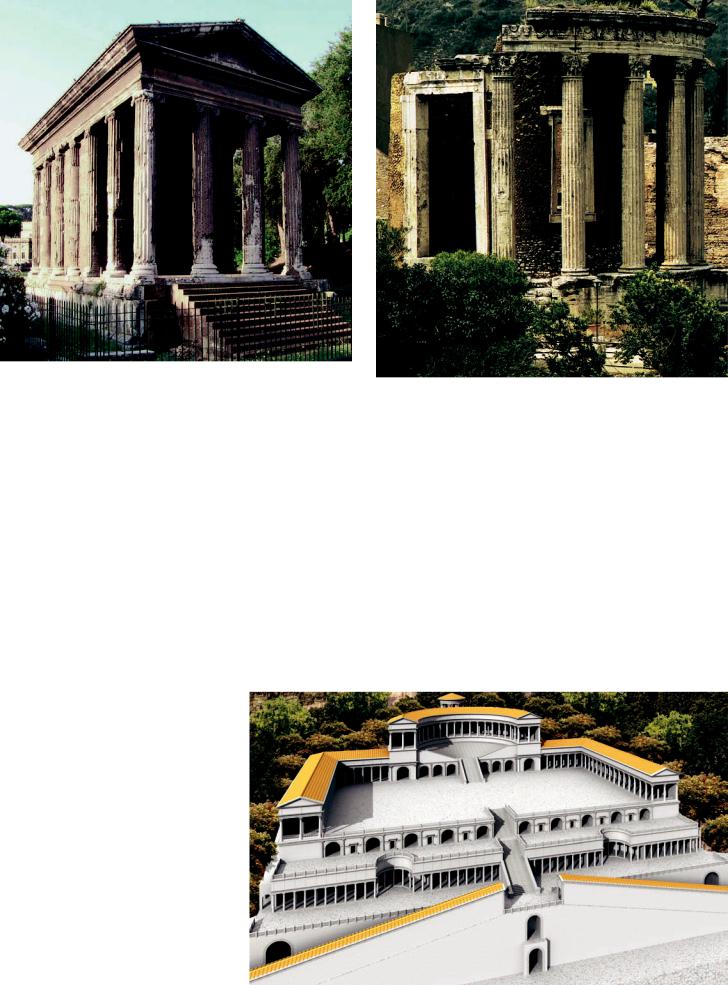
7-3 Temple of Portunus (Temple of “Fortuna Virilis”), Rome, Italy, ca. 75 BCE.
Republican temples combine Etruscan plans and Greek elevations. This pseudoperipteral stone temple employs the Ionic order, but it has a staircase and freestanding columns only at the front.
7-4 Temple of Vesta(?), Tivoli, Italy, early first century BCE.
The round, or tholos, temple type is unknown in Etruria. The models for the Tivoli temple’s builders were in Greece (FIG. 5-72), but the Roman building has a frontal orientation and a concrete cella.
TEMPLE OF VESTA, TIVOLI The Romans’ admiration for the Greek temples they encountered in their conquests also led to the importation into Republican Italy of a temple type unknown in Etruscan architecture—the round, or tholos, temple. At Tivoli (ancient Tibur), on a dramatic site overlooking a deep gorge, a Republican architect erected such a Greek-inspired temple (FIG. 7-4) early in the first century BCE. The temple is circular in plan—standard for shrines of Vesta—and has travertine Corinthian columns. The frieze is carved with garlands held up by oxen heads, also in emulation of Greek models. But the high podium can be reached only via a narrow stairway leading to the cella door. This arrangement introduced an axial alignment not found in Greek tholoi (FIG. 5-72),
7-5 Restored view of the Sanctuary of Fortuna Primigenia, Palestrina, Italy, late second century BCE (John Burge).
Fortuna’s hillside sanctuary at Palestrina was made possible by the use of concrete barrel vaults for terraces, ramps, shops, and porticos spread out over several levels. A tholos temple crowned the complex.
where, as in Greek rectangular temples, steps continue all around the structure. Also in contrast with the Greeks, the Roman builders constructed the cella wall not with masonry blocks but with a new material of recent invention: concrete (see “Roman Concrete Construction,” page 161).
SANCTUARY OF FORTUNA, PALESTRINA The most impressive and innovative use of concrete during the Republic was in the Sanctuary of Fortuna Primigenia (FIG. 7-5), the goddess of good fortune, at Palestrina (ancient Praeneste, formerly an Etruscan city). The great complex was constructed in the late second century BCE. Spread out over several terraces leading up the hillside to a tho-
160 Chapter 7 T H E RO M A N E M P I R E

A R C H I T E C T U R A L B A S I C S
Roman Concrete Construction
The history of Roman architecture would be very different had the Romans been content to use the same building materials as the Greeks, Etruscans, and other ancient peoples. Instead, the Ro-
mans developed concrete construction, which revolutionized architectural design. Roman concrete was made from a changing recipe of lime mortar, volcanic sand, water, and small stones (caementa, from which the English word cement derives). Builders placed the mixture in wooden frames and left it to dry. When the concrete hardened completely, they removed the wooden molds, leaving behind a solid mass of great strength, though rough in appearance. The Romans often covered the rough concrete with stucco or with marble revetment (facing). Despite this lengthy procedure, concrete walls were much less costly to construct than walls of imported Greek marble or even local tufa and travertine.
The advantages of concrete go well beyond cost, however. It is possible to fashion concrete shapes that masonry construction cannot achieve, especially huge vaulted and domed rooms without internal supports. Concrete enabled Roman builders to think of architecture in revolutionary ways. Roman concrete became a vehicle for shaping architectural space.
The most common types of Roman concrete vaults and domes are
Barrel Vaults Also called the tunnel vault, the barrel vault (FIG. 7-6a) is an extension of a simple arch, creating a semicylindrical ceiling over parallel walls. Pre-Roman builders constructed barrel vaults using traditional ashlar masonry (FIG. 2-24), but those earlier vaults were less stable than concrete barrel vaults. If even a single block of a cut-stone vault comes loose, the whole vault may collapse. Also, masonry barrel vaults can be illuminated only by light entering at either end of the tunnel. Using concrete, Roman builders could place windows at any point in a barrel vault, because once the concrete hardens, it forms a seamless sheet of “artificial stone” in which the openings do not lessen the vault’s structural integrity. Whether made of stone or concrete, barrel vaults
require buttressing (lateral support) of the walls below the vaults to counteract their downward and outward thrust.
Groin Vaults A groin or cross vault (FIG. 7-6b) is formed by the intersection at right angles of two barrel vaults of equal size. Besides appearing lighter than the barrel vault, the groin vault needs less buttressing. The barrel vault’s thrust is concentrated along the entire length of the supporting wall. The groin vault’s thrust, however, is concentrated along the groins, the lines at the juncture of the two barrel vaults. Buttressing is needed only at the points where the groins meet the vault’s vertical supports, usually piers. The system leaves the area between the supports open, permitting light to enter. Groin vaults, like barrel vaults, can be built using stone blocks—but with the same structural limitations when compared with concrete vaulting.
When a series of groin vaults covers an interior hall (FIG. 7-6c; compare FIG. 7-46), the open lateral arches of the vaults form the equivalent of a clerestory of a traditional timber-roofed structure (for example, FIG. 8-10). Such a fenestrated (with openings or windows) sequence of groin vaults has a major advantage over wooden clerestories. Concrete vaults are relatively fireproof, always an important consideration given that fires were common occurrences (see “Timber Roofs and Stone Vaults,” Chapter 12, page 313).
Hemispherical Domes The largest domed space in the ancient world for more than a millennium was the corbeled, beehive-shaped tholos (FIG. 4-21) of the Treasury of Atreus at Mycenae. The Romans were able to surpass the Mycenaeans by using concrete to construct hemispherical domes (FIG. 7-6d), which usually rested on concrete cylindrical drums. If a barrel vault is described as a round arch extended in a line, then a hemispherical dome may be described as a round arch rotated around the full circumference of a circle. Masonry domes, like masonry vaults, cannot accommodate windows without threatening their stability. Concrete domes can be opened up even at their apex with a circular oculus (“eye”), allowing much-needed light to reach the vast spaces beneath (FIGS. 7-35 and 7-51).
a
b |
|
|
7-6 Roman concrete construction. (a) barrel vault, |
c |
d |
(b) groin vault, (c) fenestrated sequence of groin vaults, |
|
|
(d) hemispherical dome with oculus (John Burge). |
|
|
Concrete domes and vaults of varying designs enabled Roman builders to revolutionize the history of architecture by shaping interior spaces in novel ways.
los at the peak of an ascending triangle, the layout reflects the new Republican familiarity with the terraced sanctuaries of the Hellenistic East. The means of construction, however, was distinctly Roman. The builders used concrete barrel vaults (FIG. 7-6a) of enormous strength to support the imposing terraces and to cover the great ramps leading to the grand central staircase, as well as to give shape
to the shops selling food, souvenirs, and the like, aligned on two consecutive levels. In this way, the Romans transformed the entire hillside, subjecting nature itself to human will and rational order. The Palestrina sanctuary is emblematic of the growing dominance of Rome in the Mediterranean world. By the end of the second century BCE, Romulus’s village of huts belonged to the legendary past.
Republic 161
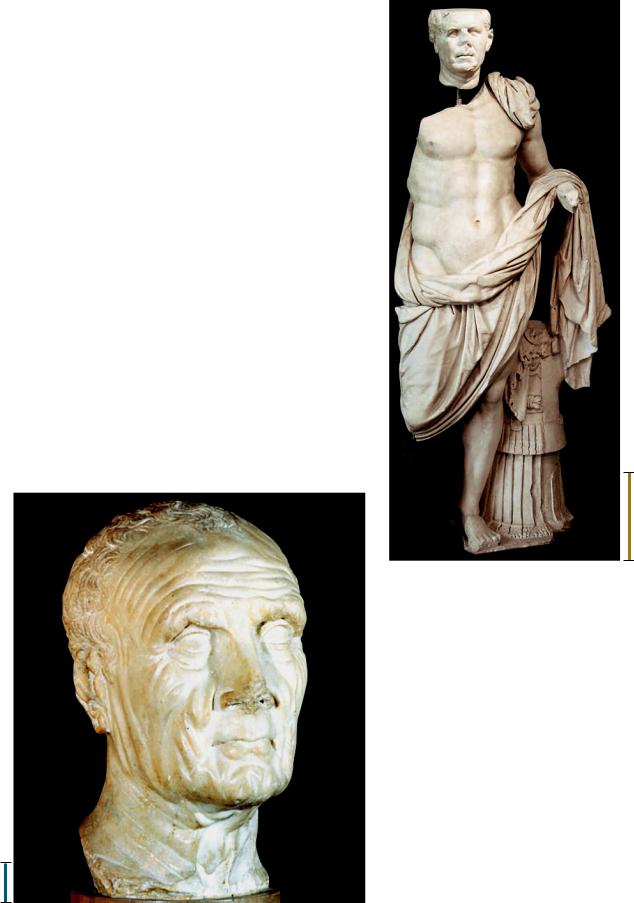
Sculpture
Nearly all the builders of Republican temples and sanctuaries were men from old and distinguished families. Often they were victorious generals who used the spoils of war to finance public works. These aristocratic patricians were fiercely proud of their lineage. They kept likenesses (imagines) of their ancestors in wooden cupboards in their homes and paraded them at the funerals of prominent relatives. Portraiture was one way the patrician class celebrated its elevated position in society. The case of Marius, a renowned Republican general who lacked a long and distinguished genealogy, underscores the importance of ancestral imagines in elite circles. Marius’s patrician colleagues in the Senate ridiculed him as a man who had no portraits in his home.
VERISM The subjects of these portraits were almost exclusively men (and to a lesser extent women) of advanced age, for generally only elders held power in the Republic. These patricians did not ask sculptors to make them appear nobler than they were, as Kresilas portrayed Pericles (FIG. 5-41). Instead, they requested brutally realistic images with distinctive features, in the tradition of the treasured household imagines. One of the most striking of these so-called veristic (superrealistic) portraits is the head (FIG. 7-7) of an unidentified patrician from Osimo. The sculptor painstakingly recorded each rise and fall, each bulge and fold, of the facial surface, like a mapmaker who did not want to miss the slightest detail of surface change. Scholars debate whether such portraits were truly blunt records of actual features or exaggerated types designed to make a statement about personality: serious, experienced, determined, loyal to family and state—virtues that were much admired during the Republic.
7-8 Portrait of a Roman general,
from the Sanctuary of Hercules, Tivoli, Italy, ca. 75–50 BCE. Marble, 6 2 high.
Museo Nazionale Romano–Palazzo Massimo alle Terme, Rome.
The sculptor based this life-size portrait of a general on idealized Greek statues of heroes and athletes, but the man’s head is
a veristic likeness. The eclectic combination is typical of Republican art.
1 in.
7-7 Head of an old man, from Osimo, mid-first century BCE. Marble, life-size. Palazzo del Municipio, Osimo.
Veristic (superrealistic) portraits of old men from distinguished families were the norm during the Republic. The sculptor of this head painstakingly recorded every detail of the elderly man’s face.
162 Chapter 7 T H E RO M A N E M P I R E
1 ft.
TIVOLI GENERAL The Osimo head also illustrates that the Romans believed the head alone was enough to constitute a portrait. The Greeks, in contrast, believed the head and body were inseparable parts of an integral whole, so their portraits were always full length (FIG. 5-87). In fact, in Republican portraiture, veristic heads were often—although incongruously—placed on bodies to which they could not possibly belong. Such is the case in the curious and discordant portrait of a general (FIG. 7-8) found at Tivoli. The cuirass (leather breastplate) at his side, which serves as a prop for the heavy marble statue, is the emblem of his rank. But the general does not appear as he would in life. Although he has a typically stern and lined Republican head, it sits atop a powerful, youthful, almost nude body. The sculptor modeled the portrait on the statues of Greek athletes and heroes the Romans admired so much and often copied (see Chapter 5). The incorporation of references to Greek art in these portrait statues evoked the notion of patrician cultural superiority and elevated the person portrayed to heroic status.
NONELITE PORTRAITURE In stark contrast to this elite tradition of publicly displaying portraits, slaves and former slaves could not possess any family portraits, because under Roman law, their parents and grandparents were not people but property. Freed slaves, however, often ordered portrait reliefs (FIGS. 7-9 and 7-10) for their tombs to commemorate their new status as Roman citizens (see “Art for Former Slaves,” page 163).
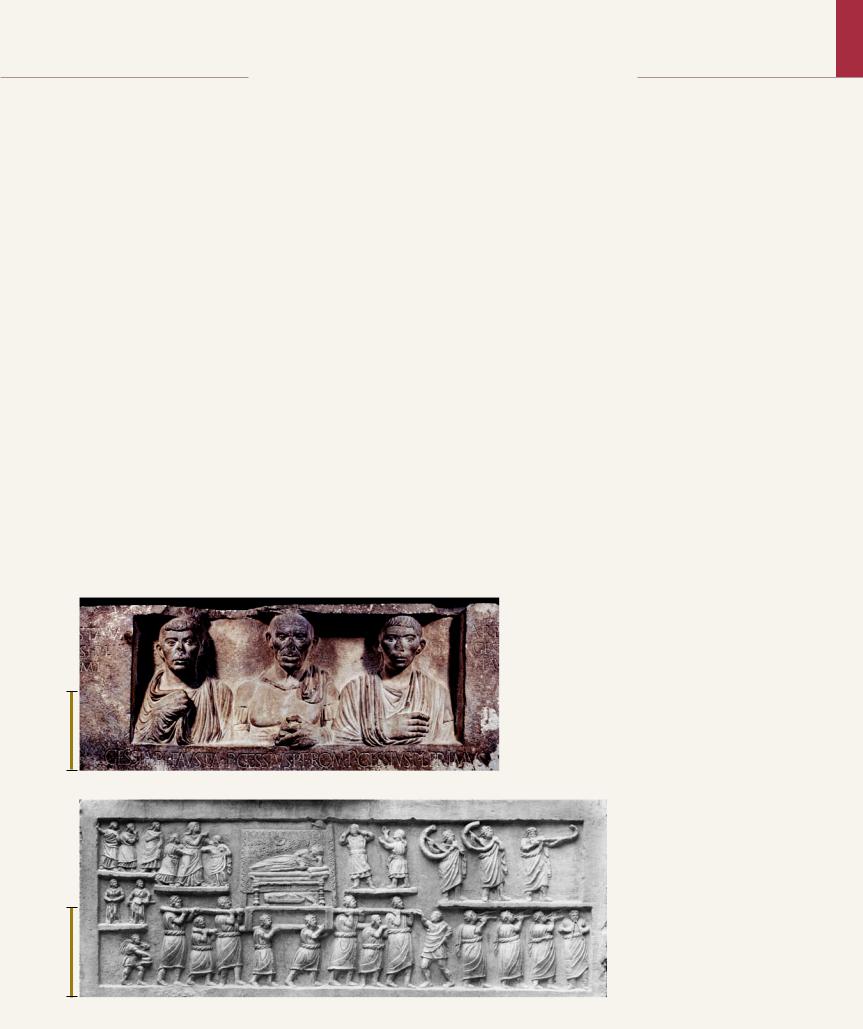
A R T A N D S O C I E T Y
Art for Former Slaves
Historians and art historians alike tend to focus on the lives and monuments of famous individuals, but some of the most interesting remains of ancient Roman civilization are the artworks commissioned by ordinary people, especially former slaves, or freedmen and freedwomen. Slavery was common in the Roman world. Indeed, researchers estimate that Italy at the end of the Republic had some two million slaves, or roughly one slave for every three citizens. The very rich might own hundreds of slaves, but slaves could be found in all but the poorest households. The practice was so much a part of Roman society that even slaves often became slave owners when their former masters freed them. Some gained freedom in return for meritorious service. Others were only freed in their masters’ wills. Most
slaves died as slaves in service to their original or new owners.
The most noteworthy artworks that Roman freedmen and freedwomen commissioned are the stone reliefs that regularly adorned their tomb facades. One of these reliefs (FIG. 7-9) depicts three people, all named Gessius. At the left is Gessia Fausta, at the right Gessius Primus. Both are the freed slaves of Publius Gessius, the freeborn citizen in the center, shown wearing a general’s cuirass and portrayed in the standard Republican veristic fashion (FIGS. 7-7 and 7-8). As slaves this couple had no legal standing. They were the property of Publius Gessius. After they were freed, however, they became people by law. These stern frontal portraits proclaim their new status as legal members of Roman society—and, by including him in the relief, their gratitude to Publius Gessius for granting them that status.
As was the custom, the two former slaves bear their patron’s name, but whether they are sister and brother, wife and husband, or unrelated is unclear. The inscriptions on the relief explicitly state that the
monument was paid for with funds provided by the will of Gessius Primus and that the work was directed by Gessia Fausta, the only survivor of the three. The relief thus depicts the living and the dead side by side, indistinguishable except by the accompanying message. This theme is common in Roman art and affirms that death does not break bonds formed in life.
More rarely, freed slaves commissioned tomb reliefs that were narrative in character. A relief (FIG. 7-10) from Amiternum depicts the honorary funeral cortege, complete with musicians, professional female mourners who pull their hair in a display of feigned grief, and the deceased’s wife and children. The deceased is laid out on a bier with a canopy as a backdrop, much like the figures on Greek Geometric vases (FIG. 5-2). Surprisingly, however, the dead man here props himself up as if still alive, surveying his own funeral. This may be an effigy, like the reclining figures on the lids of Etruscan sarcophagi (FIGS. 6-5 and 6-15), rather than the deceased himself.
Compositionally, the relief is also unexpected. Mourners and musicians stand on floating ground lines, as if on flying carpets. They are not to be viewed as suspended in space, however, but as situated behind the front row of pallbearers and musicians. This sculptor, in striking contrast to the (usually Greek) artists the patrician aristocracy employed, had little regard for the rules of Classical art. The Amiternum artist studiously avoided overlapping and placed the figures wherever they fit, so long as they were clearly visible. This approach to making pictures was characteristic of pre-Classical art, but it had been out of favor for several centuries. There are no similar compositions in the art of the consuls and senators of the Roman Republic. In ancient Rome’s cosmopolitan world, as today, stylistic tastes often were tied to a person’s political and social status.
7-9 Funerary relief with portraits of the Gessii, from
Rome(?), Italy, ca. 30 BCE. Marble, 2 1– high. Museum
1
2
of Fine Arts, Boston.
Roman freedmen often placed reliefs depicting themselves and their former owners on the facades of their tombs. The portraits and inscriptions celebrated their freedom and new status as citizens.
1 ft.
7-10 Relief with funerary procession, from Amiternum, Italy, second half of first century BCE. Limestone, 2 2 high. Museo
Nazionale d’Abruzzo, L’Aquila.
This depiction of a procession of mourners and musicians in honor of a dead freedman has figures standing on floating ground lines. The sculptor ignored the rules of
1 ft. Classical art that elite patrons favored.
Republic 163
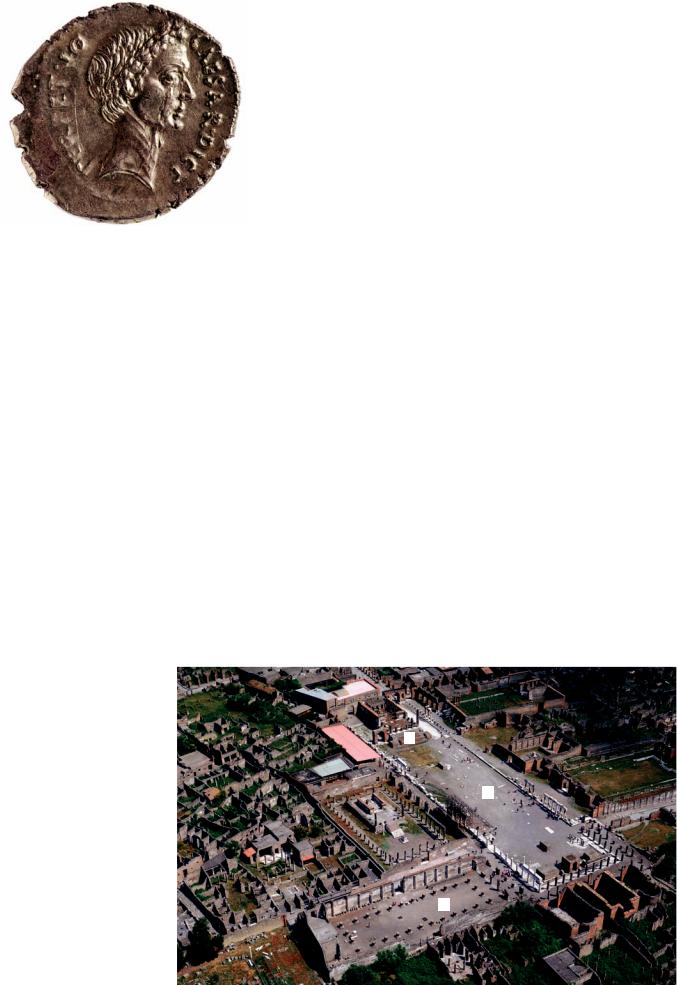
7-11 Denarius with portrait of Julius Caesar, 44 BCE. Silver, diameter
– . American Numismatic Society, New York.
3
4
Julius Caesar was the first to place his own portrait on the Roman coinage during his lifetime. This denarius, issued just before his assassination, shows the dictator with a deeply lined face and neck.
JULIUS CAESAR Beginning early in the first century BCE, the Roman desire to vaunt distinguished ancestry led to the placement of portraits of illustrious forebears on Republican coins. These ancestral portraits supplanted the earlier Roman tradition (based on Greek convention) of using images of divinities on coins. No Roman, however, dared to place his own likeness on a coin until 44 BCE, when Julius Caesar, shortly before his assassination on the Ides of March, issued coins featuring his portrait and his newly acquired title, dictator perpetuo (dictator for life). The denarius (the standard Roman silver coin, from which the word penny ultimately derives) illustrated here (FIG. 7-11) records Caesar’s aging face and receding hairline in conformity with the Republican veristic tradition. But placing the likeness of a living person on a coin violated all the norms of Republican propriety. Henceforth, Roman coins, which circulated throughout the vast territories under Roman control, would be used to mold public opinion in favor of the ruler by announcing his achievements—both real and fictional.
7-12 Aerial view of the forum (looking northeast), Pompeii, Italy, second century BCE and later. (1) forum, (2) Temple of Jupiter (Capitolium), (3) basilica.
The center of Roman civic life was the forum. At Pompeii, colonnades frame a rectangular plaza with the Capitolium at the northern end. At the southwestern corner is the basilica, Pompeii’s law court.
POMPEII AND THE CITIES
OF VESUVIUS
On August 24, 79 CE, Mount Vesuvius, a long-dormant volcano, suddenly erupted (see “An Eyewitness Account of the Eruption of Mount Vesuvius,” page 165). Many prosperous towns around the Bay of Naples (the ancient Greek city of Neapolis), among them Pompeii, were buried in a single day. This event was a catastrophe for the inhabitants of the Vesuvian cities but became a boon for archaeologists and art historians. When researchers first explored the buried cities in the 18th century, the ruins had been undisturbed for nearly 1,700 years. The Vesuvian sites permit a reconstruction of the art and life of Roman towns of the Late Republic and Early Empire to a degree impossible anywhere else.
The Oscans, one of the many Italic tribes that occupied Italy during the peak of Etruscan culture, were the first to settle at Pompeii. Toward the end of the fifth century BCE, the Samnites, another Italic people, took over the town. Under the influence of their Greek neighbors, the Samnites greatly expanded the original settlement and gave monumental shape to the city center. Pompeii fought with other Italian cities on the losing side against Rome in the so-called Social War that ended in 89 BCE, and in 80 BCE Sulla founded a new Roman colony on the site, with Latin as its official language. The colony’s population had grown to between 10,000 and 20,000 when, in February 62 CE, an earthquake shook the city, causing extensive damage. When Mount Vesuvius erupted 17 years later, repairs were still in progress.
Architecture
Walking through Pompeii today is an unforgettable experience. The streets, with their heavy flagstone pavements and sidewalks, are still there, as are the stepping stones that enabled pedestrians to cross the streets without having to step in puddles. Ingeniously, the city planners placed these stones in such a way that vehicle wheels could straddle them, enabling supplies to be brought directly to the shops, taverns, and bakeries. Tourists still can visit the impressive concrete-vaulted rooms of Pompeii’s public baths, sit in the seats of its theater and amphitheater, enter the painted bedrooms and statue-filled gardens of private homes, even walk among the tombs outside the city’s walls. Pompeii has been called the living city of the dead for good reason.
2
1
3
164 Chapter 7 T H E RO M A N E M P I R E
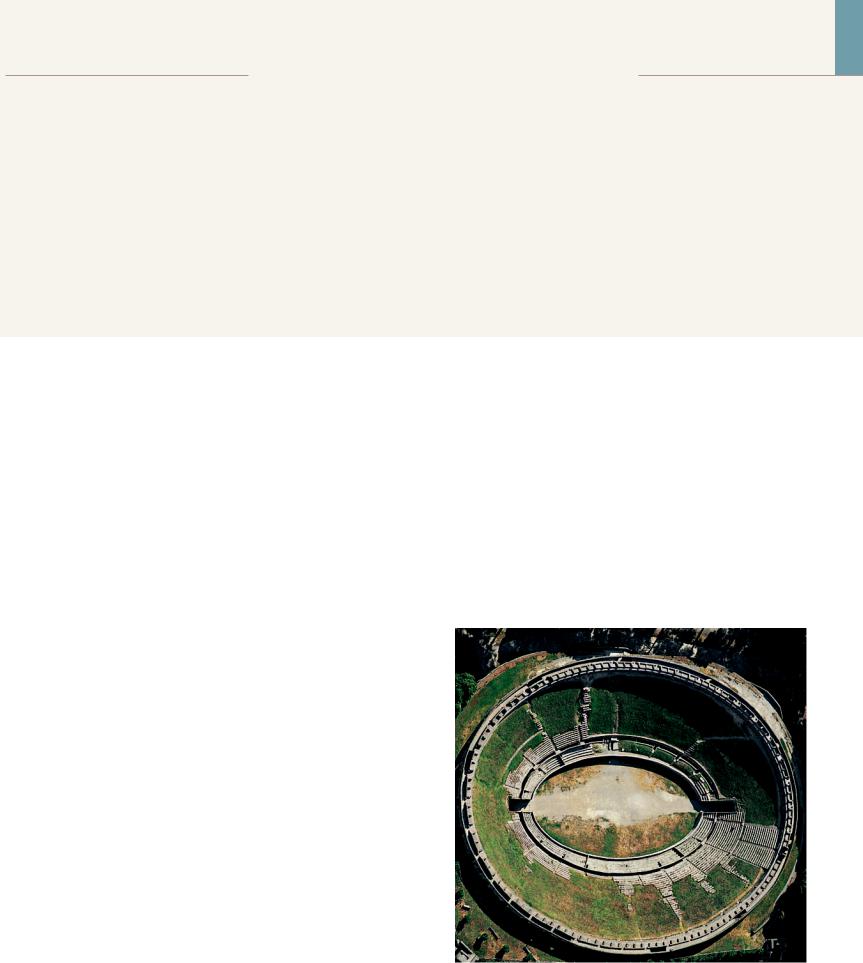
W R I T T E N S O U R C E S
An Eyewitness Account of the Eruption
of Mount Vesuvius
Pliny the Elder, whose Natural History is one of the most important sources for the history of Greek art, was among those who tried to rescue others from danger when Mount Vesuvius erupted. He was overcome by fumes the volcano spewed forth, and died. His nephew, Pliny the Younger, a government official under the emperor
Trajan, left an account of the eruption and his uncle’s death:
[The volcanic cloud’s] general appearance can best be expressed as being like a pine . . . for it rose to a great height on a sort of trunk and then split off into branches. . . . Sometimes it looked white, sometimes blotched and dirty, according to the amount of soil and ashes it carried with it. . . . The buildings were now shaking with
violent shocks, and seemed to be swaying to and fro as if they were torn from their foundations. Outside, on the other hand, there was the danger of falling pumice-stones, even though these were light and porous. . . . Elsewhere there was daylight, [but around Vesuvius, people] were still in darkness, blacker and denser than any night that ever was. . . . When daylight returned on the 26th—two days after the last day [my uncle] had been seen—his body was found intact and uninjured, still fully clothed and looking more like sleep than death.*
*Betty Radice, trans., Pliny the Younger: Letters and Panegyricus, vol. 1 (Cambridge, Mass.: Harvard University Press, 1969), 427–433.
FORUM The center of civic life in any Roman town was its forum, or public square, usually located at the city’s geographic center at the intersection of the main north-south street, the cardo, and the main east-west avenue, the decumanus (FIG. 7-42). The forum, however, generally was closed to all but pedestrian traffic. Pompeii’s forum (FIG. 7-12) lies in the southwest corner of the expanded Roman city but at the heart of the original town. The forum probably took on monumental form in the second century BCE when the Samnites, inspired by Hellenistic architecture, erected two-story colonnades on three sides of the long and narrow plaza. At the north end they constructed a temple of Jupiter (FIG. 7-12, no. 2). When Pompeii became a Roman colony in 80 BCE, the Romans converted the temple into a Capitolium—a triple shrine of Jupiter, Juno, and Minerva, the chief Roman gods. The temple is of standard Republican type, constructed of tufa covered with fine white stucco and combining an Etruscan plan with Corinthian columns. It faces into the civic square, dominating the area. This arrangement contrasts with the siting of Greek temples (FIGS. 5-42 and 5-43), which stood in isolation and could be approached and viewed from all sides, like colossal statues on giant stepped pedestals. The Roman forum, like the Etrusco-Roman temple, has a chief side, a focus of attention.
The area within the porticos of the forum at Pompeii was empty, except for statues portraying local dignitaries and, later, Roman emperors. This is where the citizens conducted daily commerce and held festivities. All around the square, behind the colonnades, were secular and religious structures, including the town’s administrative offices. Most noteworthy is the basilica (FIG. 7-12, no. 3) at the southwest corner, the earliest well-preserved building of its kind. Constructed during the late second century BCE, the basilica housed the law court of Pompeii and also was used for other official purposes. In plan it resembles the forum itself: long and narrow, with two stories of internal columns dividing the space into a central nave and flanking aisles. This scheme had a long afterlife in architectural history and will be familiar to anyone who has ever entered a church.
AMPHITHEATER Shortly after the Romans took control of Pompeii, two of the town’s wealthiest officials, Quinctius Valgus and Marcus Porcius, used their own funds to erect a large amphitheater (FIG. 7-13) at the southeastern end of town. It is the earliest amphitheater known and could seat some 20,000 spectators—more
than the entire population of the town even a century and a half after its construction. The donors would have enjoyed choice reserved seats in the new entertainment center. In fact, seating was assigned by rank, both civic and military, so that the Roman social hierarchy was on display at every event.
The word amphitheater means “double theater,” and Roman amphitheaters closely resemble two Greek theaters put together. Greek theaters were situated on natural hillsides (FIG. 5-71), but supporting an amphitheater’s continuous elliptical cavea (seating area) required building an artificial mountain. Only concrete, unknown to the Greeks, could meet that requirement. In the Pompeii amphitheater, a series of shallow concrete barrel vaults forms a giant retaining wall that holds up the earthen mound and stone seats. Barrel vaults
7-13 Aerial view of the amphitheater, Pompeii, Italy, ca. 70 BCE.
Pompeii’s amphitheater is the oldest known. It is also an early example of Roman concrete technology. In the arena, bloody gladiatorial combats and wild animal hunts were staged for 20,000 spectators.
Pompeii and the Cities of Vesuvius |
165 |
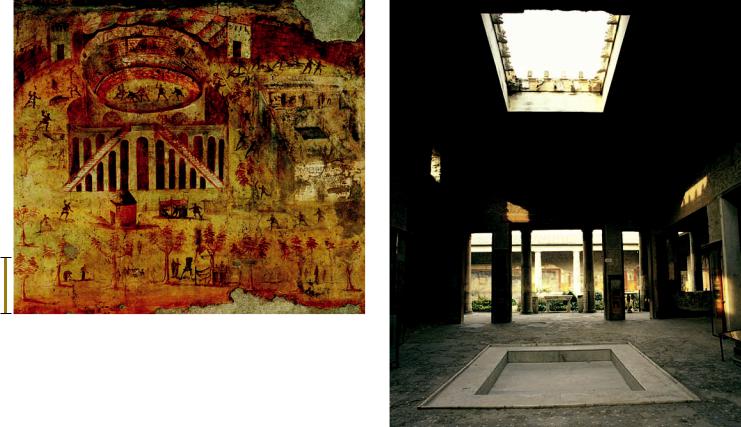
1 ft.
7-14 Brawl in the Pompeii amphitheater, wall painting from House Fresco, 5 7 6 1 . Museo
7-15 Atrium of the House of the Vettii, Pompeii, Italy, second century BCE, rebuilt 62–79 CE.
Roman townhouses had a central atrium with an impluvium to collect rainwater. Cubicula (bedrooms) opened onto the atrium, and in Hellenized houses such as this one, builders added a peristyle garden at the rear.
Painting
The houses and villas around Mount Vesuvius have yielded a treasure trove of mural paintings, the most complete record of the changing fashions in interior decoration found anywhere in the ancient world. The sheer quantity of these paintings tells a great deal about both the prosperity and the tastes of the times. How many homes today, even of the very wealthy, have custom-painted murals in nearly every room? Roman wall paintings were true frescoes (see “Fresco Painting,” Chapter 14, page 382), with the colors applied while the plaster was still damp. The process was painstaking. First the painter had to prepare the wall by applying the plaster (mixed with marble dust if the patron could afford it) in several layers with a smooth trowel. Only then could painting begin. Finally, when the surface dried, the painter polished the wall to achieve a marblelike finish.
In the early years of exploration at Pompeii and nearby Herculaneum, excavators focused almost exclusively on the figural panels that formed part of the overall mural designs, especially those depicting Greek heroes and famous myths. Workers cut the panels out of the walls and transferred them to the Naples Archaeological Museum. In time, more enlightened archaeologists halted the practice of cutting pieces out of the walls and began to give serious attention to the mural designs as a whole. Toward the end of the 19th century, August Mau, a German art historian, divided the various mural painting schemes into four so-called Pompeian Styles. Mau’s classification system, although later refined and modified in detail, still serves as the basis for the study of Roman painting.
